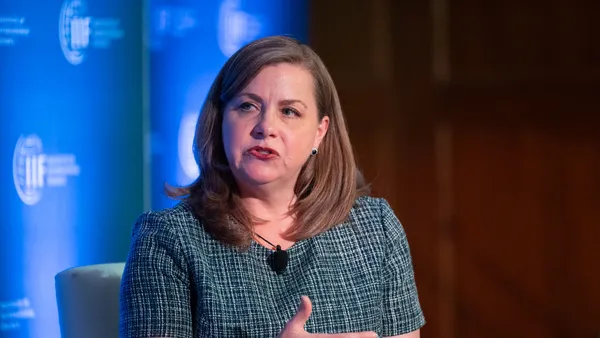Dive Brief:
- The Federal Reserve on Friday laid out new individual capital requirements for large banks, following its annual stress testing. The requirements take effect Oct. 1, the Fed said in the release.
- Morgan Stanley has asked the central bank to reduce its stress capital buffer requirement, a request the board is reviewing. The Fed expects to make a decision and publish the New York City-based bank’s final individual capital requirement by Sept. 30.
- Morgan Stanley said it “remains actively engaged” with the Fed to reach a final stress capital buffer requirement before Oct. 1.
Dive Insight:
Morgan Stanley is hardly the first big bank to challenge the Fed’s calculations. Last year, Goldman Sachs successfully petitioned the central bank to reduce its stress capital buffer requirement, from 6.4% to 6.2%. The Fed then trimmed it further, to 6.1%.
Morgan Stanley, in its quarterly filing last month, said it expected its common equity tier 1 ratio based on this year’s stress test results to come in at 12.6%. Last year’s requirement was 13.5%.
If a bank’s capital falls below the total requirement, the lender may face restrictions on capital distributions and discretionary bonus payments, the Fed noted.
Each bank’s CET1 capital requirement factors in the 4.5% minimum capital requirement, consistent for each bank; the stress capital buffer requirement, which is at least 2.5% and partly based on stress test results; and, for the largest and most complex banks, a capital surcharge that’s updated in the first quarter of the year, according to the Fed.
Of all large banks, Deutsche Bank’s CET1 requirement for the upcoming year is the highest, at 16%. Citi’s is second, at 11.6%, and JPMorgan Chase’s requirement is close behind, at 11.5%, the Fed said.
Goldman Sachs’ requirement for the coming year is 10.9% – down from 13.6% last year – while Bank of America’s is 10%.
Big-bank capital requirements are informed by the Fed’s stress test results. Those were released in June, with all 22 banks demonstrating they have sufficient capital to withstand a severe recession and continue lending while remaining above minimum capital requirements. This year’s scenario wasn’t as harsh as last year’s, however.
In April, the central bank proposed averaging stress test results over two consecutive years, intended to reduce year-to-year ups and downs in calculating capital requirements. If the proposed rule is finalized, 2025’s stress test results would be averaged with 2024’s, and updated capital requirements published separately, the Fed said.
“As the Board continues to fulfill its commitment to reducing year-over-year volatility and increasing transparency of the stress test, the individual capital requirements announced today represent a period of transition,” Michelle Bowman, the Fed’s vice chair for supervision, said in Friday’s release.
“Finalizing the rule proposed in April would be an important next step to reducing year-over-year volatility in bank capital requirements,” Bowman said. “This would allow the Board to publish revised stress capital buffer requirements once the rule is finalized, based on averaged stress test results.”
As central bank regulators reconsider the capital framework for large U.S. lenders, the Fed has also proposed changes in recent months to the enhanced supplementary leverage ratio and the supervisory rating framework for big banks.













